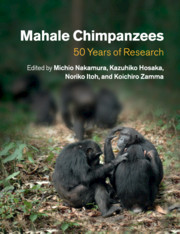Description
Mahale Chimpanzees
50 Years of Research
Coordinators: Nakamura Michio, Hosaka Kazuhiko, Itoh Noriko, Zamma Koichiro
A major contribution to great-ape research, covering every aspect of the Mahale Mountain Chimpanzee Project to offer new, unique insights.
Language: English
Mahale Chimpanzees
Publication date: 06-2020
Support: Print on demand
Publication date: 06-2020
Support: Print on demand
Mahale Chimpanzees
Publication date: 09-2015
797 p. · 19.8x25.3 cm · Hardback
Publication date: 09-2015
797 p. · 19.8x25.3 cm · Hardback
Description
/li>Contents
/li>Biography
/li>
Long-term ecological research studies are rare and invaluable resources, particularly when they are as thoroughly documented as the Mahale Mountain Chimpanzee Project in Tanzania. Directed by Toshisada Nishida from 1965 until 2011, the project continues to yield new and fascinating findings about our closest neighbour species. In a fitting tribute to Nishida's contribution to science, this book brings together fifty years of research into one encyclopaedic volume. Alongside previously unpublished data, the editors include new translations of Japanese writings throughout the book to bring previously inaccessible work to non-Japanese speakers. The history and ecology of the site, chimpanzee behaviour and biology, and ecological management are all addressed through firsthand accounts by Mahale researchers. The authors highlight long-term changes in behaviour, where possible, and draw comparisons with other chimpanzee sites across Africa to provide an integrative view of chimpanzee research today.
List of contributors; Foreword; Preface; Acknowledgements; 1. Introduction Michio Nakamura; Part I. History and Overview: 2. Overview of the field site: Mahale Mountains and their surroundings; 3. Research history; 4. Chimpanzee distribution: accumulation of survey reports; 5. Who's who; Part II. Social Organization: 6. Social system: features and variations; 7. Demography of the M group; 8. Home range; 9. Fission–fusion grouping; 10. Disappearance of K group male chimpanzees: re-examination of group extinction; 11. Intergroup relationships; Part III. Ecology: 12. Climate and climatological trends in the Kasoje Forest; 13. Mahale flora: its historical background and long-term changes; 14. Patterns and trends in fruiting phenology: some implications for important chimpanzee diet; 15. Mammalian fauna; 16. Interspecific relationships; Part IV. Feeding: 17. Diet and feeding behavior; 18. Taste of chimpanzee foods; 19. Seeds from feces: implications for seed dispersal and fecal analyses; 20. Hunting and food sharing; 21. Insect-feeding behavior and insect fauna: with special reference to plant–insect relationships; Part V. Life History and Health: 22. Development and growth: with special reference to mother–infant relationships; 23. Gerontology; 24. Chimpanzee self-medication: a historical perspective of the key findings; 25. Diseases and deaths: variety and impact on social life; 26. Conspecific killings; Part VI. Social Relations: 27. Male-male relationships; 28. Female–female relationships; 29. Male–female relationships: affiliative, interventional, and dominant–subordinate interactions; 30. Orphans and allomothering; Part VII. Social Behavior: 31. Intimidation display; 32. Aggression and conflict management; 33. Greetings and dominance; 35. Sexual behavior and mating strategies; 36. Social play: history of the studies at Mahale and a new perspective; 37. Ethograms and the diversity of behaviors; Part VIII. Behavioral Diversity: 38. Culture; 39. Vocal communication; 40. Diversity of play; 41. Laterality of hand function; 42. Use of tools and other objects; 43. Bed making and nocturnal behavior; Part IX. From Field to Lab: 44. Field endocrinology; 45. Skeletal and dental morphology; 46. Genetic studies; 47. Internal parasites; Part X. People and Chimpanzees: 48. Current status of tourism; 49. Culture and subsistence ecology of the Tongwe, and their significance in chimpanzee research; 50. Conservation and the future; Appendix I. Plant list; Appendix II. Dietary list; Appendix III. Mammal list; Appendix IV. Meteorological data collected at Kansyana, 1983–2013; Appendix V. List of researchers who visited Mahale; Appendix VI. List of abbreviations used for Mahale chimpanzee names; Appendix VII. Research and conservation funds for Mahale; Index.
Michio Nakamura is Associate Professor at the Wildlife Research Center, Kyoto University, Japan. He has studied the Mahale chimpanzees since 1994 and is a recipient of the Primate Society of Japan's Takashima Prize.
Kazuhiko Hosaka is Associate Professor at Kamakura Women's University, Japan. His research focuses on the social interactions, hunting and meat-eating behaviour of chimpanzees in relation to human evolution.
Noriko Itoh is a researcher in the Wildlife Research Center, Kyoto University, Japan. She has studied the Mahale chimpanzees since 1995, focusing on grouping behaviours and related environments.
Koichiro Zamma is a researcher in the Graduate School of Asian and African Area Studies and in the Wildlife Research Center, both at Kyoto University, Japan. His research focuses on the impact of ectoparasite infections on grooming and on the sleep-related behaviours of chimpanzees.
Kazuhiko Hosaka is Associate Professor at Kamakura Women's University, Japan. His research focuses on the social interactions, hunting and meat-eating behaviour of chimpanzees in relation to human evolution.
Noriko Itoh is a researcher in the Wildlife Research Center, Kyoto University, Japan. She has studied the Mahale chimpanzees since 1995, focusing on grouping behaviours and related environments.
Koichiro Zamma is a researcher in the Graduate School of Asian and African Area Studies and in the Wildlife Research Center, both at Kyoto University, Japan. His research focuses on the impact of ectoparasite infections on grooming and on the sleep-related behaviours of chimpanzees.
© 2024 LAVOISIER S.A.S.




